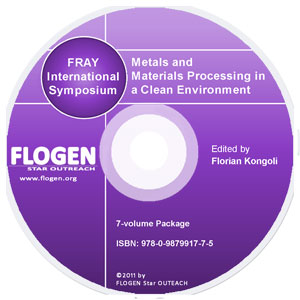
CD shopping page |
2011-Sustainable Industrial Processing Summit
|
| Editors: | Florian K |
| Publisher: | Flogen Star OUTREACH |
| Publication Year: | 2012 |
| Pages: | 764 pages |
| ISBN: | 978-0-9879917-5-1 |
| ISSN: | 2291-1227 (Metals and Materials Processing in a Clean Environment Series) |
Dealing With Cyanide-soluble Copper In The Gold Mining Industry
Christopher Fleming1; SELECT * FROM contact WHERE email_address REGEXP('chris.fleming@sgs.com')*********************1SGS, Lakefield, Canada;
Type of Paper: Regular
Id Paper: 339
Topic: 14
Abstract:
A significant portion of the known gold reserves in the world are contained in ores that also contain copper mineralization. Most copper minerals react quantitatively with cyanide, which is the lixiviant used universally in the gold industry to leach gold from its ores and concentrates. In practice, it is difficult to leach gold without simultaneaously leaching any cyanide soluble copper minerals that may be prtesent in the ore body. This can lead to very high cyanide consumption during leaching and high reagent consumption during cyanide consumption, which in some cases will render a potentially attractive gold prospect uneconomic. There are several ways of dealing with the problem and they all boil down to one of two choices (i) either take measures to minimize the reaction between cyanide and the copper minerals, or (ii) treat the gold plant tailings to recover copper cyanide, which allows the copper to be sold as a commercail product and the cyanide to be internally recycled to leaching.The opportunities for minimizing the reaction between copper and cyanide are limited as copper is usually present in the ore at a concentration at least 10 to 100 times greater than that of gold, and their rates of leaching are similar under typical gold leaching conditions. However, the mechanisms by which copper and gold leach in cyanide are quite different and this presents an opportunity to achieve a partial separation based on kinetic differentiation. Copper leaches in a chemically controlled reaction while gold leaches in a redox reaction in which the rate of reaction is mass transfer or diffusion controlled. Some separation can be achieved by manipulating the concnetrations of cyanide and oxygen. When copper minerals react with cyanide they form water-soluble copper cyanide complexes, and several processes have been developed to treat gold plant tailings to either extract the copper cyanide (with anion exchange resins or activated carbon) for subsequent treatment or to break it down in a chemical reaction and precipiate the copper in a recoverable form. These processes will be discussed, with particualr emphasis on the SART process, which is gaining acceptance in the gold mining industry. Gold plant tailings are treated with sulphuric acid and a source of sulphide ions in the SART process, which precipitates copper as chalcocite (Cu2S) for recovery and sale as a high grade concentrate, and restores the complexed cyanide as free cyanide for recycling to leaching. Several SART plants have been built in the last few years, and are operating successfully.